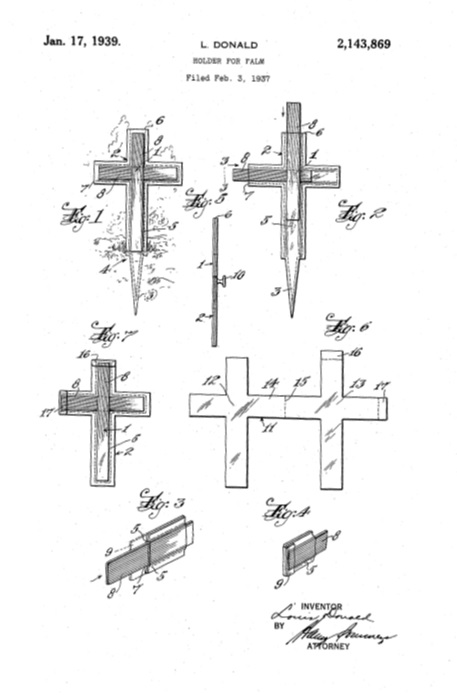It’s Palm Sunday, and U.S. Patent No. 2,143,869 provides a holder for your palms:


It’s Palm Sunday, and U.S. Patent No. 2,143,869 provides a holder for your palms:

In Intellisoft. Ltd. v. Acer America Corp., [2019-1522] (April 3, 2020), the Federal Circuit reverses the district court’s decision refusing to remand the case to state court, vacate the district court’s judgment, and remanded to the district court with instructions to remand the action to California state court.
Intellisoft Ltd. allegedly shared with Acer trade secrets concerning computer power management technology under a non-disclosure agreement (“NDA”). The NDA allowed Acer to use of their “Confidential Information” only to “directly further” the evaluation of Intellisoft’s product for licensing. Intellisoft alleges that they discovered that Acer had applied for a patent that incorporated their trade secrets and became the owner of U.S. Patent No. 5,410,713 (and related patents 5,870,613; 5,884,087; and 5,903,765). Intellisoft sued Acer in California state court. concluded that Acer had misappropriated their trade secrets and violated the NDA.
Acer cross-claimed that Intellisoft’s inventor, Bierman was not an inventor of the the ‘713 patent family, and removed the case from state court. Intellisoft sought remand to state court because no patent issues had to be resolved to determine its trade secret claim. The district court denied Intellisoft’s motion, and granted summary judgment in favor of Acer with respect to Intellisoft’s state law claims, reasoning that Intellisoft failed to prove under federal patent law that Bierman was the inventor of the ’713 patent family claims.
Under Gunn v. .Minton, when a plaintiff brings only a state law claim, as here, the district court will have original jurisdiction over the state law claim if a federal issue is: (1) necessarily raised, (2) actually disputed, (3) substantial, and (4) capable of resolution in federal court without disrupting the federal-state balance approved by Congress.
The Federal Circuit found that Acer did not establish that Intellisoft’s trade secret claim necessarily raised patent law issues. The Federal Circuit said that ownership of a trade secret under state law did not require proof of patent inventorship. The Federal Circuit further found that Intellisoft did not need to prove infringement to prove trade secret misappropriation. The ’713 patent family was only being used as evidence to support Intellisoft’s state law claims. This analysis required no construction of the claims or proof of infringement. The Federal Circuit further found that Intellisoft’s damages claim was based on using trade secrets, independent of the ‘713 patent family. Mere reliance on a patent as evidence to support its state law claims does not necessarily require resolution of a substantial patent question.
The Federal Circuit found that because Intellisoft’s trade secret claim did not necessarily depend on resolution of a substantial question of federal patent law, so it did not need to address other prongs of the Gunn test. The Federal Circuit concluded that the district court did not have jurisdiction under section 1338(a), and the state law claims could not be removed under section 1441.
The Federal Circuit further found that removal under section 1454 was improper because Acer’s counterclaim was not operative.
In Myco Industries, Inc. v. Blephex. LLC, [2019-2374] (April 3, 2020), the Federal Circuit reversed the district court’s preliminary injunction enjoining BlephEx from making allegations of patent infringement and also from threatening litigation against Myco’s potential customers over U.S. Patent No. 9,039,718, entitled “Method and Device for Treating an Ocular Disorder,”
The Federal Circuit said that when a preliminary injunction prevents a patentee from communicating its patent rights, a court applies federal patent law and precedent relating to the giving of notice of patent rights. In such cases, the grant of a preliminary injunction is reviewed in the context of whether, under applicable federal law, the notice of patent rights was properly given. The Federal Circuit further said that federal law requires a showing of bad faith before a patentee can be enjoined from communicating his patent rights. A showing of “bad faith” must be supported by a finding that the claims asserted were objectively baseless, and an asserted claim is objectively baseless if no reasonable litigant could realistically expect success on the merits.
The Federal Circuit concluded that the district court abused its discretion when it granted a preliminary injunction enjoining patentee speech with-out a finding of bad faith. The Federal Circuit said that although a district court’s discretion to enter a preliminary injunction is entitled to substantial deference, the patent laws permit a patentee to inform a potential infringer of the existence of its patent. The Federal Circuit found that the district court neither made a finding of bad faith nor even adverted to the requirement. The Federal Circuit added that to the extent the district court made any factual findings relevant to bad faith, the court expressly declined to find that any of BlephEx’s statements were either false or misleading.
The Federal Circuit rejected Myco’s argument that it would be bad faith to accuse physicians with infringement in view of 35 U.S.C. § 287(c)(1), but the Federal Circuit said the statute did not make physicians “immune from infringement,” it merely prevents the patent owner from seeking a remedy. Further, the District Court found no evidence that any threats were made.
Finally the Federal Circuit vacated the finding that Myco was likely to succeed on the merits, finding several lapses in the district court’s efforts at claim construction.
The Federal Circuit concluded:
Speech is not to be enjoined lightly. Here, there is not even a finding, let alone a finding supported by evidence and a correct view of the law, that the speech restrained was either false or misleading. The district court abused its discretion when it granted a preliminary injunction en-joining BlephEx from making allegations of patent infringement without a finding of bad faith and with no adequate basis to conclude that allegations of patent infringement would be false or misleading.